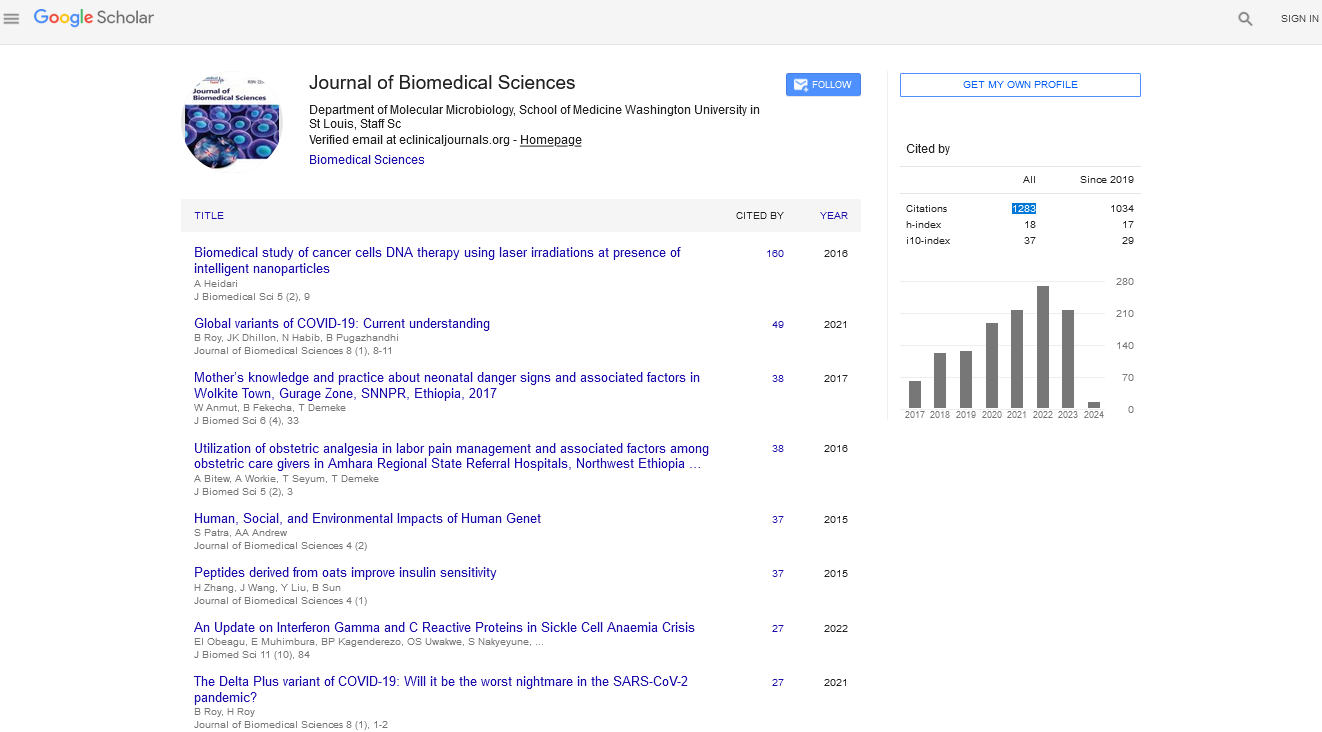Commentary - (2024) Volume 13, Issue 3
Bioinformatics: Revolutionizing Biological Research
Italo Patel*
Department of Bioinformatics, University of Milan, Italy
*Correspondence:
Italo Patel, Department of Bioinformatics, University of Milan,
Italy,
Email:
Received: 14-May-2024, Manuscript No. IPJBS-24-14876;
Editor assigned: 16-May-2024, Pre QC No. IPJBS-24-14876 (PQ);
Reviewed: 30-May-2024, QC No. IPJBS-24-14876;
Revised: 10-Jun-2024, Manuscript No. IPJBS-24-14876 (R);
Published:
18-Jun-2024
Description
In the fast-paced world of biological research, bioinformatics
has emerged as an indispensable tool, driving advancements in
genomics, proteomics, and other omics disciplines.This
interdisciplinary field combines biology, computer science,
mathematics, and statistics to analyze and interpret large sets of
biological data. From deciphering the humangenome to
predicting protein structures and understanding complex
biological systems, bioinformatics is at the forefront of scientific
discovery, revolutionizing the way we study life at the molecular
level.
Understanding bioinformatics
At its core, bioinformatics involves the development and
application of computational techniques to process, analyze, and
interpret biological data. This includes DNA sequences,
protein structures, gene expression profiles, and more. By
harnessing the power of computers and algorithms,
bioinformaticians can extract meaningful information from these
vast datasets, uncovering patterns, relationships, and insights
that would be impossible to discern through traditional
methods alone.
Applications of bioinformatics
Bioinformatics has a wide range of applications across various
fields of biological research:
Genomics: Perhaps the most well-known application of
bioinformatics is in genomics, the study of an organism's
complete set of DNA. Bioinformatics tools are used to assemble
and annotate genomes, identify genes, predict their functions,
and compare genetic sequences between different species. This
information is invaluable for understanding the genetic basis of
diseases, evolution, and biodiversity.
Proteomics: Proteomics focuses on the study of proteins,
their structures, functions, and interactions. Bioinformatics plays
a crucial role in analyzing protein sequences, predicting their 3D
structures, and identifying potential binding sites for drugs or
other molecules. This information aids in drug discovery, protein
engineering, and understanding disease mechanisms.
Transcriptomics: Transcriptomics involves the study of an
organism's complete set of RNA transcripts, including mRNA,
microRNA, and non-coding RNA. Bioinformatics tools are used to
analyze gene expression patterns, identify differentially
expressed genes, and infer regulatory networks. This helps
researchers understand how genes are turned on or off in
response to various stimuli or conditions.
Metabolomics: Metabolomics is the study of an organism's
complete set of small molecules, known as metabolites, and
their interactions within biological systems. Bioinformatics tools
are used to analyze metabolite profiles, identify metabolic
pathways, and link metabolites to physiological processes or
disease states. This information is valuable for understanding
metabolism, biomarker discovery, and drug metabolism studies.
Phylogenetics: Phylogenetics is the study of evolutionary
relationships between organisms based on genetic data.
Bioinformatics tools are used to construct phylogenetic trees,
infer ancestral relationships, and analyze the genetic diversity
within and between species. This helps researchers understand
evolutionary patterns, biodiversity, and the origins of different
organisms.
Challenges and future directions
Despite its numerous applications and benefits, bioinformatics
also faces several challenges:
Data integration: With the exponential growth of biological
data, one of the biggest challenges in bioinformatics is integrating
and harmonizing data from different sources and formats. This
requires standardized protocols, ontologies, and data sharing
initiatives to ensure interoperability and data quality.
Algorithm development: Developing accurate and efficient
algorithms for analyzing biological data remains a challenge,
particularly for complex datasets or novel research questions.
Continuous innovation in algorithm development is essential to
keep pace with advancements in technology and data
generation.
Computational resources: Analyzing large datasets requires
significant computational resources, including high-performance
computing clusters, storage facilities, and specialized software
tools. Ensuring access to these resources, particularly for
researchers in low-resource settings, is essential for advancing
bioinformatics research globally.
Ethical and legal issues: Bioinformatics raises ethical and legal
concerns related to data privacy, informed consent, and
intellectual property rights. Ensuring the responsible use of
biological data and protecting individuals' privacy and rights are
paramount in bioinformatics research.
Looking ahead, the future of bioinformatics holds exciting
possibilities:
Single-cell omics: Advances in single-cell sequencing technologies
are enabling researchers to analyze individual cells with
unprecedented resolution, leading to new insights into cellular
heterogeneity, development, and disease.
Machine learning and AI: The integration of machine learning
and artificial intelligence techniques into bioinformatics
promises to improve the accuracy and efficiency of data analysis,
enabling automated feature extraction, pattern recognition, and
predictive modeling.
Personalized medicine: Bioinformatics is playing a crucial role
in the development of personalized medicine, where treatments
are tailored to an individual's genetic makeup, lifestyle, and
environment. This approach holds promise for mproving diagnosis,
treatment, and prevention strategies for various diseases.
Environmental and agricultural applications: Bioinformatics
is increasingly being applied to environmental and agricultural
research, including microbial ecology, crop breeding, and food
safety. Understanding the complex interactions between
organisms and their environments is essential for addressing
global challenges such as climate change and food security.
In conclusion, bioinformatics is a dynamic and interdisciplinary
field that is transforming biological research and driving
innovation across multiple domains. By harnessing the power of
computational tools and data analysis techniques, bioinformatics
is unlocking the secrets of life and paving the way for new
discoveries that have the potential to revolutionize healthcare,
agriculture, and our understanding of the natural world.
Citation: Patel I (2024) Bioinformatics: Revolutionizing Biological Research. J Biomed Sci Vol:13 No:3





